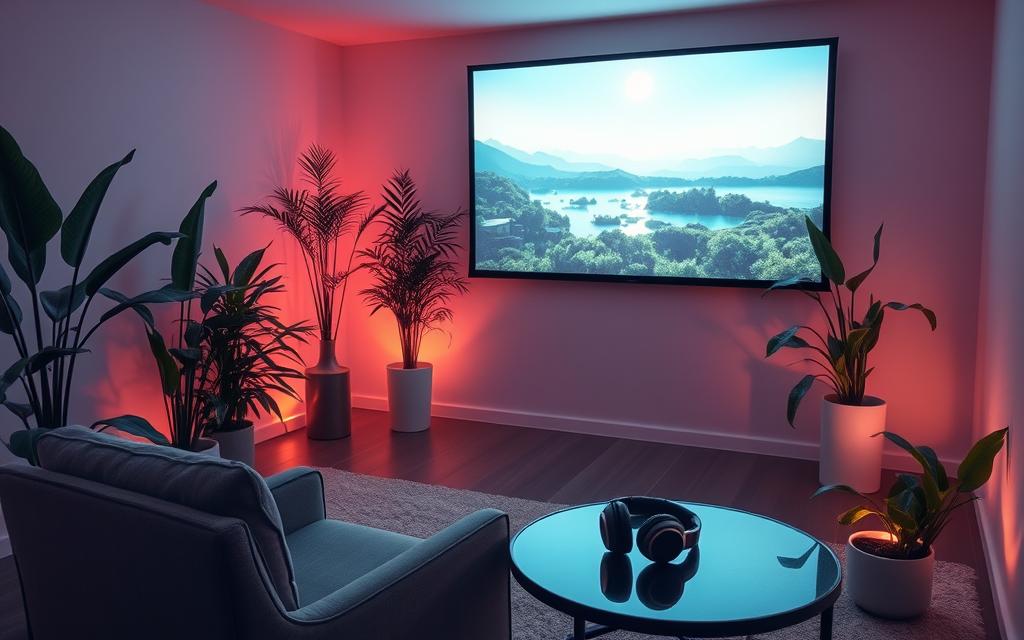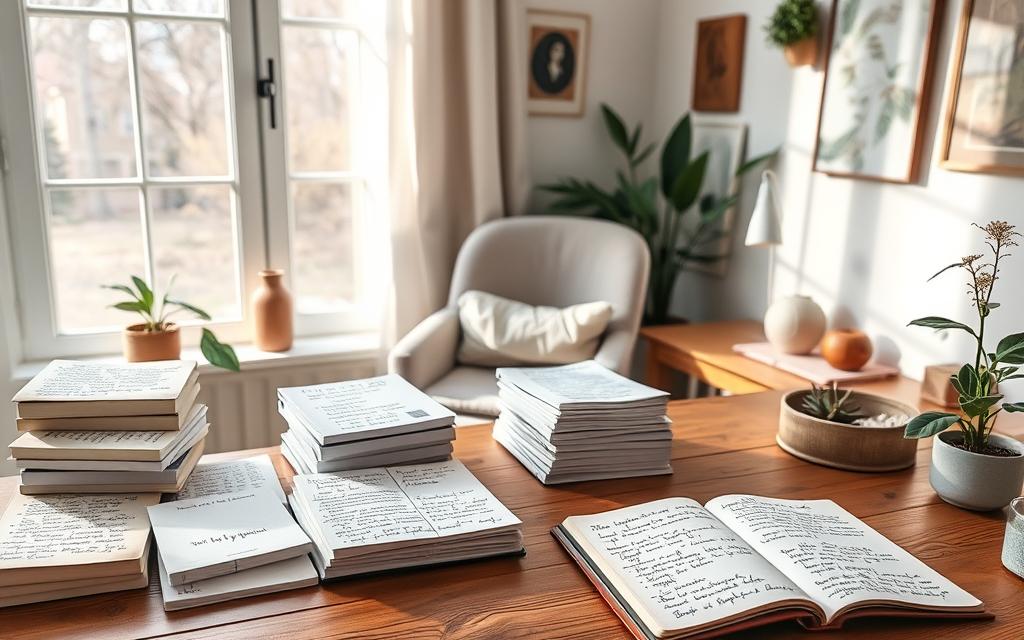Imagine unlocking your full potential easily. What if you could use your mind to change yourself deeply? Self-hypnosis scripts might be the answer. But are they just a trend, or can they really change how you think and act?
Self-hypnosis scripts are powerful tools for personal growth. They help change your mindset and behavior. By relaxing deeply, your mind accepts positive suggestions. This makes it great for solving problems like sleep issues, pain, anxiety, and improving performance.
But can these words really change your life?
Understanding the Power of Self-Hypnosis in Personal Transformation
Self-hypnosis is a powerful tool that changes our lives for the better. It uses the brain’s ability to change and adapt. Studies show it’s great for anxiety, stress, and controlling habits.
Psychological research backs it up. It says that self-hypnosis plans tailored to you work best. They help you change your behavior for good.
The Science Behind Mental Programming
Self-hypnosis reaches the subconscious mind. This is where our deep beliefs and habits live. It uses relaxation, visualization, and positive thoughts to change our minds.
Research shows it’s good for managing pain. This suggests it could help in many other ways too.
Benefits of Self-Guided Hypnotic States
Self-hypnosis lets you control the process. It’s a personal and effective way to change. It can help with fears, pain, anxiety, and more.
It can also boost your confidence and focus. Plus, it can improve your business skills. People say it makes them feel better overall.
Historical Context and Modern Applications
Self-hypnosis has a long history. It goes back to ancient times. Today, it’s used in many ways, like in sports and for stress relief.
The “Self-Applied Hypnosis Techniques” program is a great example. It offers tools like trance-talk and lesson audios. It also has a coursebook and hypnosis scripts to help you learn.
Essential Components of Effective Self-Hypnosis Scripts
Making great self-improvement recordings and guided meditation scripts needs a deep understanding. They use vivid images, metaphors, relaxation techniques, and positive affirmations. These help change our subconscious minds.
Using a journey narrative is key, like walking on a peaceful beach or climbing a calm mountain. These journeys guide us through growth and change. They engage our senses, making the experience deep and transformative.
Progressive muscle relaxation is another vital part. It helps us relax deeply and become more open to suggestions. This makes our minds ready to accept positive changes in our mental, emotional, physical, and social lives.
Effective scripts also use neurolinguistic programming (NLP) principles. This includes well-formed suggestions and language that matches our goals. It helps create lasting change and growth.

The best self-hypnosis scripts blend these elements well. They offer a complete and engaging experience. This empowers us to reach our full potential and achieve our goals.
Creating the Perfect Environment for Trance States
To achieve a deep trance state, you need the right setting. Find a quiet, comfortable spot where you can relax without distractions. This is crucial for hypnotherapy audios and self-hypnosis.
Setting Up Your Physical Space
Look for a room that encourages deep relaxation. The lighting should be soft, and the temperature just right. Remove distractions like phones and other noises. Your space should help you focus on the hypnotic script.
Optimal Time and Conditions
- Practice self-hypnosis when you’re most relaxed, like before bed or in the morning.
- Don’t do it right after eating or when you’re stressed or overstimulated.
- Make sure you’re well-rested and hydrated for the best trance states.
Eliminating Distractions
- Switch off all electronics, including phones and TVs.
- Close windows and doors to block out noise and interruptions.
- Choose a private spot to avoid unexpected visitors.
By setting up your space and timing right, you’re ready for deep hypnotherapy audios and trance states. This focus will help you get the most out of your self-hypnosis practice and personal growth.
The Role of Progressive Relaxation in Self-Hypnosis
Progressive relaxation is key in self-hypnosis. It involves tensing and relaxing muscles to relax deeply. This method helps quiet the mind and prepare it for self-hypnosis.
Studies show self-hypnosis helps with many issues like weight loss and anxiety. It follows a 12-step process, starting with finding a quiet spot and setting goals. It also includes breathing exercises, visualization, and affirmations.
A study found self-hypnosis helps with chronic pain in MS patients. Those who used self-hypnosis felt less pain than those who used muscle relaxation. The pain relief lasted for 3 months, and most kept using the technique.
Progressive relaxation is a first step in self-hypnosis. It relaxes the body and mind, making it ready for affirmations and visualizations. These steps help in mind reprogramming and achieving goals.
Experts suggest spending 10-12 minutes on progressive relaxation. It’s good for stress, anxiety, and sleep. You can use a guide or recorded audio, making it personal.

Adding progressive relaxation to self-hypnosis helps achieve a deeper trance. It unlocks the mind-body practice’s transformative power.
Crafting Powerful Affirmations for Mind Reprogramming
Positive affirmations are key to changing your mindset and reaching your full potential. They use the power of suggestion therapy and positive affirmations to change your subconscious thoughts and actions.
Structure of Effective Affirmations
Good affirmations are positive, written in the present tense, and aim for what you want. For instance, “I am becoming more organized and disciplined” or “I am learning to balance caring for others with self-care.” They are clear, believable, and touch your heart, making them strong tools for change.
Language Patterns That Create Change
- Avoid negative language and focus on the positive.
- Use “I am” statements to affirm your abilities and aspirations.
- Incorporate empowering verbs like “I can,” “I will,” and “I choose.”
- Personalize your affirmations to make them truly meaningful.
Timing and Repetition Techniques
The real strength of affirmations comes from repeating them when you’re in a hypnotic state. By saying these positive statements out loud, you can slowly change your subconscious thoughts and actions. Add affirmations to your daily self-hypnosis routine. See how they change your mindset and life.
Self-Hypnosis Scripts for Different Life Areas
Self-hypnosis scripts are a powerful tool for personal growth. They help with many life areas by tapping into the subconscious mind. This allows people to change their thoughts, beliefs, and actions to reach their goals.
Looking to manage stress, boost confidence, or beat addictions? Self-hypnosis scripts can be made just for you. They use positive affirmations, visualization, and help get rid of negative thoughts. This helps you become the best version of yourself.
For example, a script for boosting confidence might use images of you doing well in social situations and affirmations about your self-worth. A script for losing weight might include pictures of healthy eating and a positive view of your body.
These scripts are made by skilled hypnotherapy experts. They use the latest research and methods in mental programming. By using these scripts regularly, you can change your subconscious mind. This means replacing negative beliefs with positive ones that help you grow.
The secret to good self-hypnosis is keeping a positive mindset and believing you can change. With time and effort, these scripts can help you reach your full potential and grow personally.

- Stress management
- Confidence building
- Weight loss
- Smoking cessation
- Improving relationships
Remember, self-improvement is a journey that never ends. Self-hypnosis scripts are a valuable tool for your personal growth journey.
Visualization Techniques to Enhance Script Effectiveness
Visualization is a key part of self-hypnosis scripts. It’s about making detailed mental pictures of what you want or peaceful scenes. Using all your senses in these pictures makes them more powerful and effective for change.
Creating Mental Images
Making clear mental pictures is vital in self-hypnosis scripts. Picture yourself in a calm place, like a beach scene. Think about the sun’s warmth, the sound of waves, and the smell of the sea. The more senses you use, the better and more real the picture will feel.
Engaging Multiple Senses
- Sight: See the beautiful landscape, the colors, and the details of your surroundings.
- Sound: Hear the soothing sounds of nature, such as the waves crashing or birds chirping.
- Touch: Feel the warmth of the sun, the soft sand beneath your feet, or the breeze on your skin.
- Smell: Inhale the refreshing scent of the ocean or the fragrance of nearby flowers.
- Taste: Imagine the crisp, refreshing taste of a cool beverage or a healthy snack.
Using all your senses in visualization techniques makes your guided meditation scripts more real. This leads to deeper relaxation, better focus, and a stronger connection with your goals.
Integration of NLP Principles in Script Writing
Using Neuro-Linguistic Programming (NLP) in self-hypnosis script writing can change the game. NLP techniques, like anchoring, make your hypnosis sessions more effective. They help you connect with your subconscious mind’s power.
Anchoring links a physical action to a feeling or mental state. For instance, touching your index finger to your thumb can bring back a relaxed, empowered state. This is from a successful hypnosis session.
Adding NLP to your scripts creates a feedback loop that supports change. This mix of NLP techniques and subconscious programming makes it easy to enter a trance. It helps you accept positive affirmations and visualizations more easily.

Maximize your self-hypnosis by using words, images, and NLP’s proven methods. Discover the subconscious mind’s secrets. Start a journey of personal growth and change.
Recording Your Own Hypnotherapy Audios
Creating your own self-improvement recordings can be very powerful. It lets you make the hypnotherapy experience your own. You can change the scripts, voice, and background sounds to fit what you need and like.
Technical Requirements
To start, you’ll need a good microphone and recording software. Tools like Audacity are free and work well. Make sure your recording area is quiet and free from distractions for the best sound.
Voice Modulation Tips
- Speak slowly and evenly, with pauses between sentences. This creates a calm, relaxed feel.
- Use a confident and soothing voice. Choose a tone that helps you relax deeply.
- Adding background sounds or music can make the experience even better.
Recording your own self-improvement recordings and hypnotherapy audios can be a great way to help yourself. Try different methods and keep improving your scripts and how you speak. This will help you get the most out of your recordings.
Measuring Progress and Adjusting Scripts
Unlocking the power of self-hypnosis scripts needs careful tracking and flexibility. As you start your personal development journey, watch for changes in your thoughts, feelings, and actions. These changes should relate to your goals.
Begin by keeping a detailed journal of your experiences. Regularly check your progress and see how your self-hypnosis scripts affect your life. Are you noticing a shift in your mindset? Are your actions and behaviors more in line with your goals?
- Set specific, measurable goals to gauge the effectiveness of your self-hypnosis scripts.
- Be patient and understand that significant changes may take time to manifest.
- Adjust your scripts as needed, based on your evolving needs and experiences.
Remember, self-hypnosis changes your subconscious mind. By watching your progress and tweaking your scripts, you’ll unlock its full potential. This tool is a game-changer for personal growth.

Self-hypnosis is now recognized in many fields, from business to sports. It helps align your subconscious beliefs with your goals. This unlocks new levels of personal and professional growth.
Embrace the journey, celebrate your progress, and adjust your self-hypnosis scripts as needed. This ensures they keep supporting your growth.
Common Challenges and Solutions in Self-Hypnosis
Starting your self-hypnosis journey can change your life, but it comes with hurdles. One big challenge is relaxing the mind and body to reach the trance state. It’s hard to trance states and dive into suggestion therapy when your mind keeps wandering.
Another hurdle is mental resistance from not understanding hypnosis well. Some people doubt its power or worry about losing control. Breaking down these mental walls is key to unlocking self-hypnosis’s full potential.
Overcoming Mental Resistance
- Start with an open and curious attitude towards self-hypnosis, not skepticism.
- Learn about the science behind trance states and suggestion therapy to clear up myths.
- Begin with small goals and celebrate each success to build confidence.
Maintaining Focus and Concentration
- Use deep breathing and body scans to relax before you start.
- Try guided imagery and visualization to keep your focus when your mind drifts.
- Find the best place and time to practice that helps you stay focused.
Self-hypnosis is a skill that needs time and effort to get good at. With patience and regular practice, you can beat the common obstacles and tap into its powerful benefits.
Advanced Techniques for Deepening Trance States
Going beyond basic relaxation, experienced self-hypnosis users explore advanced methods to deepen trance states. These techniques make their self-guided hypnotic sessions more effective.
Fractionation is a technique that alternates between trance and wakefulness. This back-and-forth process can lead to deeper hypnosis. It makes the mind more open to powerful suggestions and visualizations.
- Confusion inductions use special language patterns to disorient the conscious mind. This helps create a trance state.
- Time distortion methods change how time is perceived. This can deepen the hypnotic experience even more.
These advanced hypnosis inductions are very effective but need practice. They are best for those with experience in self-hypnosis. Yet, mastering them can lead to deeper trance states. This opens the door to personal growth and development.
Combining Scripts with Other Self-Improvement Methods
Using self-improvement recordings can be even more powerful when you mix them with other self-care habits. Adding self-hypnosis scripts to journaling, setting goals, and mindfulness can help you reach your goals better.
For instance, combining a confidence-boosting self-hypnosis script with daily affirmations and social activities can help with social anxiety. The script works on your subconscious, while affirmations and social activities help you see the changes on the surface.
Also, mixing a self-hypnosis script for personal transformation with journaling can give you deeper insights. The script changes your beliefs, and the journal tracks your progress and growth areas.
By trying different self-improvement methods, you can make a strong plan for your goals and the life you want. It’s important to find what works best for you.
The path to self-improvement is unique for everyone. Be open to trying new things and trust the journey as you work on yourself.
Building a Personal Library of Self-Hypnosis Resources
Creating a personal library of self-hypnosis resources can change your life. Start by gathering a variety of self-hypnosis scripts and hypnotherapy audios that meet your needs. Look for scripts from well-known hypnotherapists and authors. Their knowledge can guide you well.
While pre-written scripts are useful, making them your own is key. Customize the scripts with your affirmations and visualization. This makes them more effective, aligning your subconscious with your goals.
- Invest in books on self-hypnosis, covering science and practical use of hypnotic techniques.
- Check out online resources, like playlists of hypnotherapy audios and guided meditations, to grow your library.
- Consider workshops or hypnotherapist guidance to learn more and get personal advice.
Building a good library of self-hypnosis resources is a journey. Keep looking for new materials, trying different techniques, and improving your methods. This will help you achieve the changes you want.
Conclusion
Self-hypnosis scripts are powerful tools for mind transformation. They help you change your mind by understanding how to write effective scripts. You also need to create the right environment and practice regularly.
Remember, scripts are just the start. The best results come from making them your own and using them with other self-improvement methods.
The Elman Induction method is fast, taking only 2-3 minutes to make you more open to suggestions. This is much quicker than the usual 10-15 minutes it takes with other methods. It uses muscle suggestions, challenge tests, and deepeners to quickly put you into a hypnotic state.
In the end, self-hypnosis scripts are a great tool for personal growth. They help you change your thoughts, beliefs, and actions. Whether you want to be more disciplined, sleep better, or break free from negative thoughts, these scripts can be a big help.
